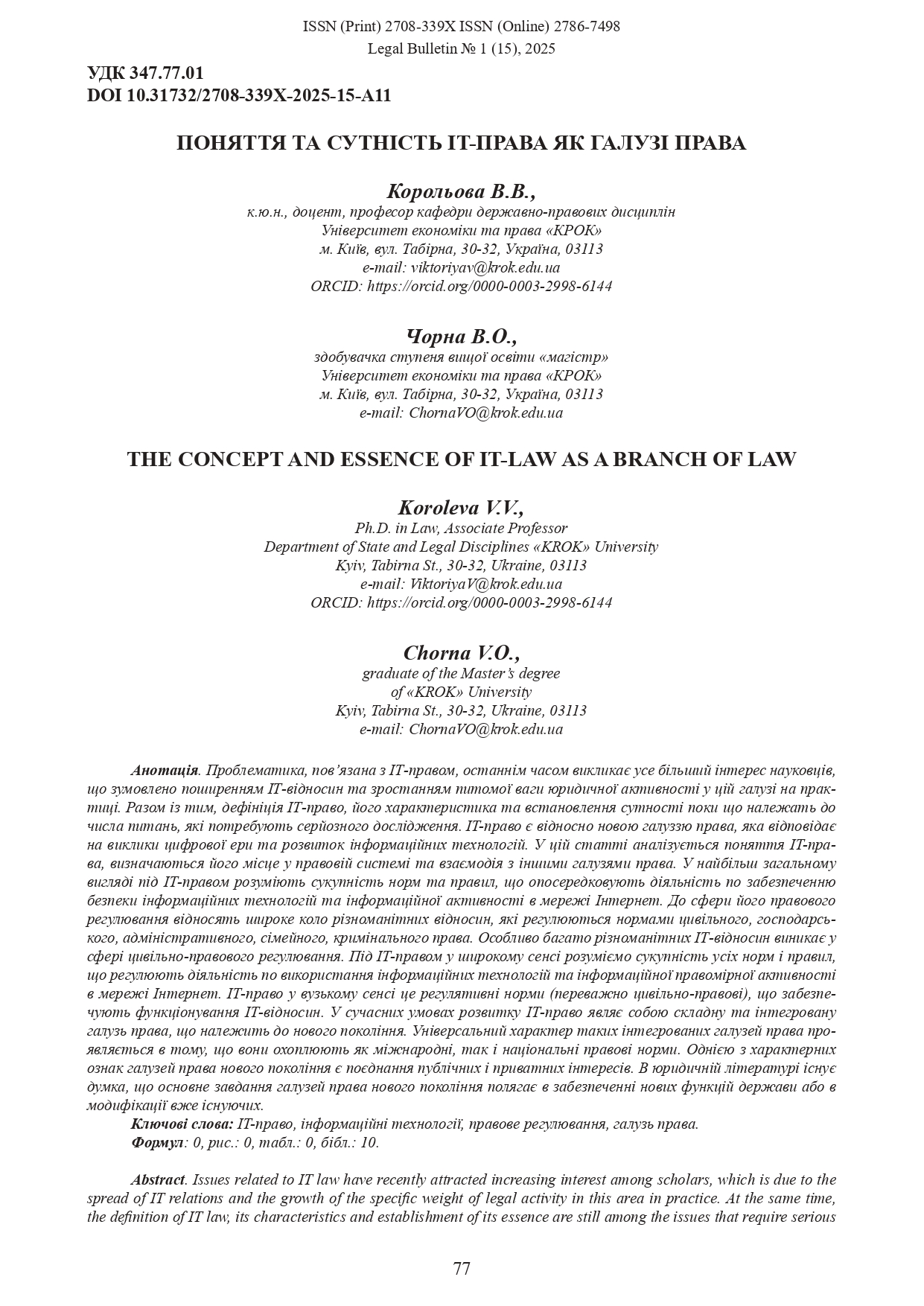THE CONCEPT AND ESSENCE OF IT-LAW AS A BRANCH OF LAW
DOI:
https://doi.org/10.31732/2708-339X-2025-15-A11Keywords:
IT law, information technology, legal regulation, branch of lawAbstract
. Issues related to IT law have recently attracted increasing interest among scholars, which is due to the spread of IT relations and the growth of the specific weight of legal activity in this area in practice. At the same time, the definition of IT law, its characteristics and establishment of its essence are still among the issues that require serious research. IT law is a relatively new branch of law that responds to the challenges of the digital era and the development of information technologies. This article analyzes the concept of IT law, determines its place in the legal system and interaction with other branches of law. In the most general form, IT law is understood as a set of norms and rules that mediate activities to ensure the security of information technologies and information activity on the Internet. The scope of its legal regulation includes a wide range of various relations that are regulated by the norms of civil, economic, administrative, family, and criminal law. Especially many various IT relations arise in the field of civil law regulation. IT law in a broad sense is understood as a set of all norms and rules that regulate the use of information technologies and lawful information activity on the Internet. IT law in a narrow sense is regulatory norms (mainly civil law) that ensure the functioning of IT relations. In modern conditions of development, IT law is a complex, integrated branch of law of a new generation. The universal nature of integrated branches of law is manifested in the fact that they simultaneously cover both the norms of international and national law. A characteristic feature of the branches of law of a new generation is the combination of public and private interests. In legal literature, a point of view is expressed according to which the main purpose of the branches of law of a new generation is to serve new or modify established functions of the state.
References
Марценюк О. Теоретико-методологічні засади інформаційного права України: реалізація права на інформацію : дис. … канд. юрид. наук : 12.00.07. Київ, 2009. 266 с.
Калюжний Р. Предмет та методи інформаційного права. Правова інформатика. 2008. № 3. С. 5-9.
Бачинський Т., Радейко Р. Основи ІТ-права: навч. посіб. 3-тє вид., допов. і перероб. К. Юрінком Інтер. 2019. 244 с.
Яворська О. С. ІТ-право. Л. Левада. 2017. 470 с.
Конституція України від 28 червня 1996 р. Відомості Верховної Ради України. 1996. № 30. Ст. 141.
Харитонов Є. О., Харитонова О. І. Сутність ІТ-права: пошук парадигми. Право України. 2018. № 1. С. 18-29.
Сімсон О. ІТ-право з позицій теорії та практики, підходи до вивчення і викладання. Право України. 2018. № 1. C. 51-62.
Міхайліна Т. В., Мазур Я. В. ІТ-Право у системі права: дискусійні моменти сучасності. Науковий вісник Ужгородського Національного Університету, 2024. Серія Право. Випуск 84. Ч. 3. С. 144-151.
Тарасенко Л. Правова природа Інтернет-права. Вісник Львівського університету. 2021. № 72. С. 47-54.
Тицька Я. О., Поварчук Н. С. Доктринальні підходи щодо визначення статусу права інформаційних технологій. Київський часопис права. 2023. № 1. С. 41-46.

Downloads
Published
How to Cite
Issue
Section
License
Copyright (c) 2025 Корольова В.В., Чорна В.О.

This work is licensed under a Creative Commons Attribution 4.0 International License.




